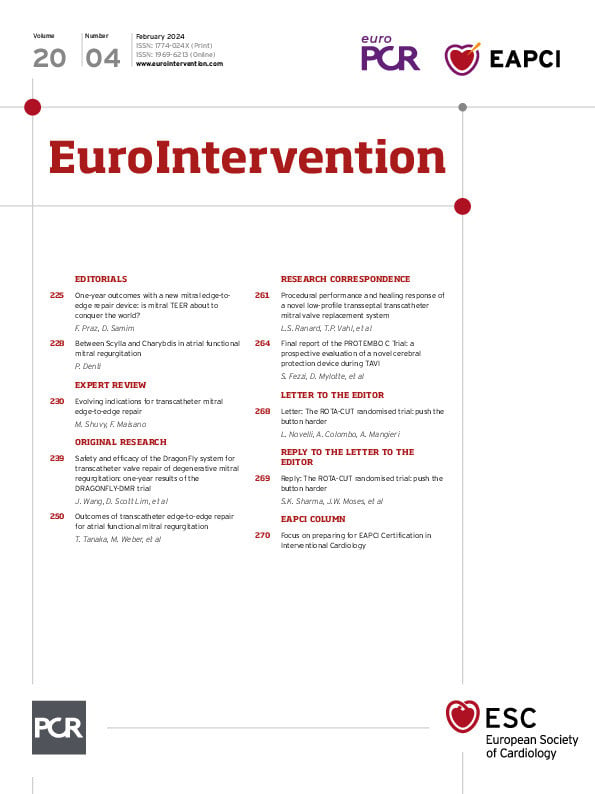The prevalence of mitral regurgitation (MR) tends to rise with age, and its impact on the elderly population is a subject of clinical significance. Appropriate management is crucial to improve outcomes and the quality of life for these individuals. For operable patients, the gold standard remains surgery, but in high-risk/inoperable patients, transcatheter edge-to-edge repair (TEER) has been shown to be a safe and feasible option, especially if anatomical criteria are favourable (Class IIa indication1). Of note, in the setting of secondary mitral regurgitation, the COAPT study, a randomised control trial comparing TEER with medical therapy, revealed the prognostic benefit of TEER in secondary MR patients2. In recent years, atrial functional mitral regurgitation (AFMR) has been identified as a distinct phenotype in the field of secondary MR with specific echocardiographic criteria (normal left ventricular [LV] systolic function, no or mild LV enlargement without wall abnormality, and moderate or severe left atrial [LA] enlargement3). Until now, neither COAPT nor any other study has described the specific results of TEER in AFMR patients.
In this issue of EuroIntervention, Tanaka and colleagues4, however, carefully describe the outcomes of TEER in AFMR patients, with a consideration of residual gradients and their impact on outcomes. Using data from the Bonn registry, Tanaka evaluated 125 patients with AFMR characteristics (28.3% of those in the study). These are the main findings: in patients with AFMR, residual MR ≤1+ with a mitral valve pressure gradient (MPG) ≥5 mmHg, as well as residual MR >1+, was associated with a higher risk of the composite outcome (all-cause death and hospitalisation due to heart failure at 1 year) than residual MR ≤1+ with an MPG <5 mmHg. In contrast, an MPG ≥5 mmHg was associated with a higher risk of the composite outcome in AFMR but not in ventricular functional mitral regurgitation (VFMR). Second, AFMR patients with residual MR ≤1+ with an MPG ≥5 mmHg had a poorer improvement in New York Heart Association (NYHA) Functional Class than those with MR ≤1+ and an MPG <5 mmHg. It’s obvious that residual gradients ≥5 mmHg are detrimental and result in suboptimal TEER. Unfortunately, Tanaka et al have not identified the anatomical factors that help favour a higher postprocedural gradient. We know that AFMR patients had a higher LV ejection fraction, smaller LV volumes, and a larger LA volume than those with VFMR. Of note, the MPG at baseline was higher in patients with AFMR (1.7 mmHg vs 1.5 mmHg; p=0.058), but the severity of MR was comparable. Despite higher gradients, the mitral annulus diameter was greater in patients with AFMR than in those with VFMR (38 mm vs 37 mm; p<0.001). An MPG ≥5 mmHg was more frequent in patients with AFMR than in those with VFMR (21.6% vs 13.3%; p=0.030). Most importantly, severe or greater tricuspid regurgitation was more frequent in patients with AFMR than in those with VFMR, meaning that atrial fibrillation is a very severe disease that affects all atrioventricular valves. A higher left atrial pressure may only be detrimental to the right heart chamber and tricuspid valve competence. Counterintuitively, AFMR patients with good results and lower gradients also had a smaller LA volume index.
These findings suggest that an accurate anatomical preprocedural selection5 using a multiparametric approach is mandatory in order to obtain the smallest residual gradient. This includes measuring the intercommissural extension of the jet, assessing the area of the mitral opening6, carrying out periprocedural continuous direct monitoring of the left atrial pressure7 (which was not achieved in this study), and measuring the final geometrical area of the mitral orifice in diastole.
We now have different sizes of device, and in AFMR we must choose a “narrower” device, or one with a spacer, to maximise the reduction of MR with respect to the gradient. If the first device does not completely abolish MR, using a smaller device as a second device is possible. Perhaps a reproducible device for annuloplasty would be more favourable for gradients and subsequent interventions8. A strategy of “annuloplasty first” for AFMR could also pave the way to a successive transcatheter mitral valve replacement or represent a docking station for the implant.
In conclusion, the Achilles' heel of TEER for AFMR is the detrimental effect of a high gradient, despite the abolition of MR. Further studies are needed to identify the best anatomical criteria that favour MR elimination. In the meantime, continuous monitoring of left atrial pressure and the use of a “narrower” device could be pursued. In future, an “annuloplasty first” strategy could also be evaluated.
Conflict of interest statement
The author receives speaker honoraria from Abbott and Edwards Lifesciences and is a consultant for HVR Cardio, Approxima, Pi-Cardia, and InnovHeart.

